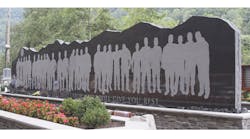MSHA said it has addressed the 100 recommendations made by an internal-review team in the aftermath of the April 2010 Upper Big Branch Mine disaster.
The agency said it had implemented the recommendations as of Dec. 31, “meeting the specific timetables and deadlines it had set for implementation of each recommendation.”
The review team examined MSHA’s actions in the months leading up to the Upper Big Branch Mine explosion, which killed 29 miners, injured two and led to sweeping changes in mine safety. The April 5, 2010, explosion at the Upper Big Branch Mine-South in Montcoal, W.Va., was the largest coalmine disaster in the United States in 40 years.
“The internal review was designed to identify shortcomings so that we, as an agency, could take necessary actions to improve mine safety and health,” said Joseph Main, assistant secretary of labor for mine safety and health. “The result was one of the most comprehensive internal reviews in MSHA history, and the most extensive improvements at the agency in decades.”
In June 2012, MSHA began posting on its website quarterly updates of the corrective actions that had been completed. The agency noted that it “did not wait for the internal-review team to publish its findings and put in place a number of administrative, organizational and regulatory reforms in the immediate aftermath of the tragedy.” According to MSHA, these reforms included:
- Enhanced enforcement programs, such as impact inspections and a revised pattern of violations process.
- The splitting of the southern West Virginia coal district into two districts.
- The upgrading of the Mt. Hope, W. Va., laboratory for better coal-dust and gas analyses.
- Reorganization of the Office of Assessments, Accountability, Special Enforcement and Investigations to better manage and support MSHA’s enforcement programs.
- Publication of final regulations on the maintenance of rock dust, examinations in underground mines and the pattern of violations program to rein in chronic violators.
“Meeting the self-imposed timelines was a major challenge,” said Main, pointing to other demands facing the agency, such as mission-critical needs, sequestration and the 16-day government shutdown. “MSHA was able to maintain the schedule throughout the process and finish corrective actions on time, which is a testament to the hard work and dedication of our employees.”
Other corrective actions have included:
- Revision or development of more than 40 policy directives, including the significant revision of mine inspection procedure handbooks and the development of a new coal roof control handbook.
- More than 20 separate training sessions for MSHA personnel on issues raised by the internal review.
- Creation of a centralized system to establish better oversight of all agency directives and policy guidance and to ensure their consistency.
- Modification of the Mine Plan Approval database system.
- Integration of a common tracking system to track inspector re-training.
- Creation (with the Holmes Safety Association and mining community) of a national mine-rescue organization to support and provide guidance on mine rescue.
“The Upper Big Branch tragedy unquestionably shook the very foundation of mine safety,” said Main. “It caused us to re-double our efforts to instill a culture of prevention in mining. These corrective actions are part of MSHA's ongoing efforts to improve health and safety conditions in the nation's mines so that miners can go to work, do their jobs and return home to their loved ones safe and healthy at the end of every shift.”
As a result of actions taken by MSHA and the mining community, MSHA noted that there have been a number of mine-safety improvements, including:
- Substantially fewer mines with chronic-violation records.
- A record number of temporary reinstatements and discrimination cases filed on behalf of miners.
- Reduced respirable-dust levels to lowest exposure levels in history.
- The lowest fatal and injury rates in 2011 and in 2012.
- The lowest fatal and injury rates and number of mining deaths ever recorded in a fiscal year.
A list of MSHA’s corrective actions can be found on MSHA's Upper Big Branch web page.
